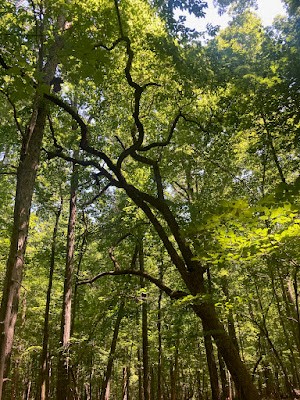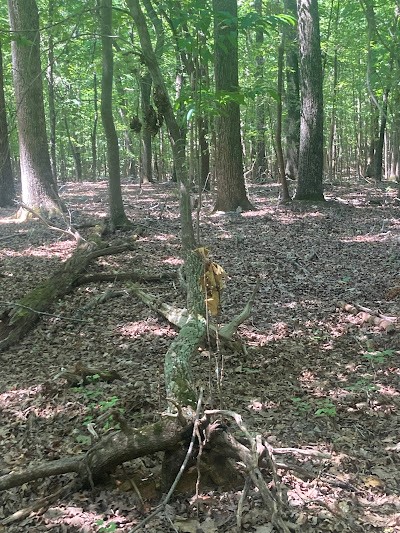Guest post by Steven Feuerstein, TLC Volunteer and Founder of TriWild

Can trees move under their own volition? Of course they can and do, as long as they are alive. First of all, there are trees that “walk”. But even ignoring such an outlier, it should be obvious after just a bit of thought (and observation throughout spring) that trees are always moving under their own volition (that is, independent of wind). They just don’t move across the surface of the planet. They move up and out from the surface, towards the sun.
For many trees, this results in trunks that grow straight up (i. e., roughly perpendicular to the surface), like loblolly pines (telephone pole trees), since that is the fastest way to grab a place in the canopy and maximize the rays of the sun (i.e., food via the miracle of chlorophyll and photosynthesis).
Yet for other trees, movement towards the sun can look more like an elegant and exuberant dance up through the understory.
The prime-est, most wonderful-est example I know of: Oxydendrum arboreum, a.k.a., Sourwood, Lily of the Valley Tree, Sorrel Tree. I believe, however, that they be called Dancers.
It’s called “Sourwood” because if you chew on the leaf, your face will get all scrunchy. Give it a try – but don’t swallow!
Besides its taste, it’s easy to identify sourwoods by:
- Bark: “red-brown with deep vertical furrows that separate flat, pointed ridges.” Here’s an example of a mature sourwood trunk:
- Leaf: longish oval leaves which turn shades of crimson-red to reddish-purple color in the fall. Oh, and did I mention sour?
- Their dance: by which I mean the way they grow towards the sun. Of course, all trees do whatever they can to maximize access to sunlight. It seems to me, however, that sourwoods have evolved to give them an above-average ability to wind their way up and through the understory.
The bottom line – if you see a dark trunk that is growing at an angle, it is almost certainly a sourwood. And not just an angle: a curve this way, then that, pivoting and pirouetting. Finding a spot of sun and then quickly filling it with its long leaves. Here’s one of my favorites:
And another:
Apologizing in advance for the less-than-stellar quality of my photography, take a close look at the image below (for higher resolution click here).
I count over a dozen sourwoods bending and twisting in this photo.
Given that sourwoods lean so much, it’s not surprising to find that many of them get toppled by storms and falling trees. But I get the feeling that a survival strategy for sourwood is that its roots don’t easily snap. As a result, it is very common to find sourwoods that have fallen and are almost horizontal, but continue to live and grow. Here’s an example; you can see the uprooting at the bottom, but up at the top you can see a whole bunch of sourwood leaves (again, high res here).
I’ve been taking lots of pictures of sourwoods dancing through the understory. You can see them all here, but I offer this montage:

Of course, the main thing is for you to experience sourwoods yourself, directly and in the woods. I can recommend two trails that are full of sourwoods: Brumley South‘s Buckeye Loop and Springhouse Loop. But I guarantee that once you internalize “maroon bark” and “curving trunk”, you will suddenly see sourwoods everywhere.





